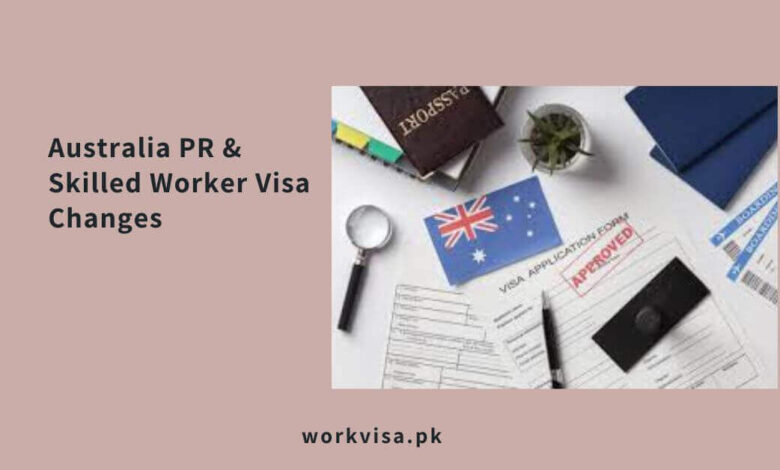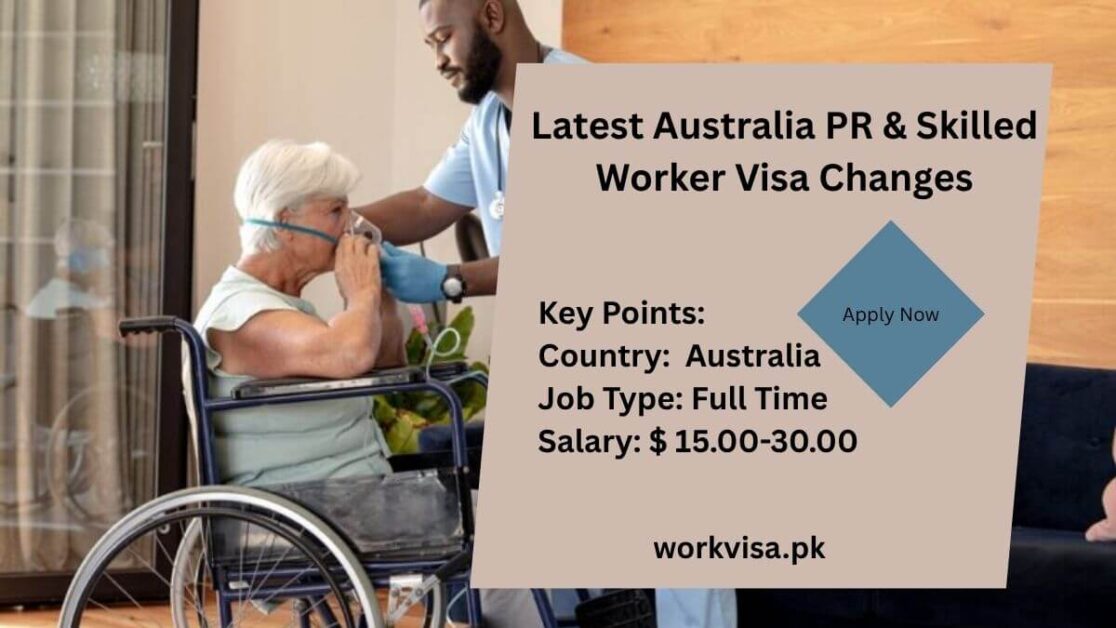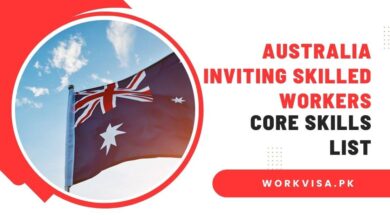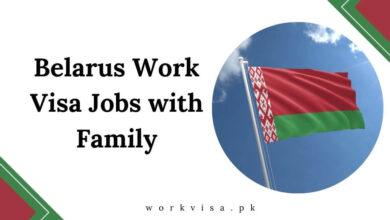Australia PR & Skilled Worker Visa Changes 2025 Update

In 2025, the immigration landscape of Australia is enduring substantial changes, particularly in the areas of Permanent Residency (PR) and Skilled Worker visas. The objective of these modifications is to ensure that migration policies are in accordance with the nation’s changing economic requirements, labor market demands, and regional development objectives.

Australian Gifted Specialist Visa:
The Global Talent Relocation (GSM) program in Australia includes the Talented Laborer Visa. It is designed for external professionals who possess skills that are in high demand in the Australian labor market. This visa allows candidates to reside and work in Australia for a specified period of time, or for an indefinite period, contingent upon the visa subclass.
The primary talented visa categories include:
- Subclass 189 – Gifted Free Visa
- Subclass 190 – Gifted Assigned Visa
- Subclass 491 – Talented Work Territorial (Temporary) Visa
- Skills in Request (SID) Visa (supplanting Subclass 482 TSS visa)
Key Upgrades:
Introduction of the Aptitudes in Request (SID) Visa
In May 2025, the Australian government authoritatively rolled out the Aptitudes in Request (SID) visa. This modern visa replaces the Temporary Aptitude Deficiency (TSS) visa and aims to simplify the process for employers and talented specialists. It incorporates three particular streams:
- Specialist Aptitudes Stream: For individuals who are profoundly accomplished and work in sectors with pay rates that exceed a high income threshold.
- Core Abilities Stream: For components that are listed on the contemporary Center Abilities Occupation List (CSOL).
- Specialists in fundamental but lower-paid sectors, such as the care and community support sectors, are eligible for the Essential Abilities Stream.
The work encounter prerequisite has moreover been reduced to a fair one year within the final five, a long time for qualified candidates, making the method more accessible.
Launch of the Center for Aptitude Occupation List (CSOL):
Australia has supplanted the more seasoned Gifted Occupation List with the Center Abilities Occupation List (CSOL). This modern list is custom-fitted to current workforce deficiencies and incorporates need divisions such as:
- Information technology
- Cybersecurity
- Renewable energy
- Engineering
- Construction
- Healthcare
- Agriculture
The CSOL will be overhauled routinely to reflect labor requests in real-time, advertising more adaptability for skilled migrants.
Points Framework Adjustments:
Points-tested visas (Subclass 189, 190, and 491) continue to operate under the Common Gifted Movement program. In any case, modifications have been implemented to enhance competitiveness and accommodate evolving labor requirements. The following are the primary components:
- Age
- English dialect proficiency
- Work experience
- Education qualifications
- Partner skills
- Australians think about requirements
Also Check: Visa Sponsorship Berries Picking Jobs in Australia – Benefits & Free Stay
Changes in Need Processing:
Applicants in fundamental occupations and those under the Skills in Demand (SID) visa receive expedited training. This ensures that the workforce remains responsive to the country’s requirements and addresses urgent industry deficiencies.
Increase in Pay Threshold:
The Brief Gifted Relocation Pay Limit (TSMIT) was expanded and continues to be balanced every year in line with normal compensation. As of July 2025, it is indexed to rise, guaranteeing talented specialists are paid decently and the program isn’t abused for low-wage labor.
Types:
- Subclass 189 – Gifted Free Visa: This visa may serve as a permanent resident visa for exceptional professionals who are not dependent on a supervisor, state or region, or household member. It is entirely derived from the focus test and, in a sense, integrates the CSOL.
- Subclass 190 – Gifted Designated Visa: This visa is intended for candidates who have been designated by an Australian state or territory government and is also intended for permanent residency. The selected individuals must be employed in occupations that are listed on the state-specific occupation list.
- This could be a five-year provisional visa for individuals who are willing to reside and work in territorial Australia, known as Subclass 491 – Talented Work Regional (Provisional) Visa. In the event that specific criteria are satisfied, it may result in changeless residency through the Subclass 191 visa.
- Skills in Request (SID) Visa: The most recent and dynamic category, the SID visa enables skilled workers to enter Australia based on labor market requirements and employer sponsorship, without the previous complications of the TSS visa.
Step-by-Step Application Process:
Follow the steps below to apply for work visa in Australia
Step 1: Check Your Eligibility:
Before applying, you must guarantee that you meet the minimum qualification criteria, including:
- Under the age of 45
- A positive assessment of one’s abilities for a significant position on the CSOL
- Proficiency in the English language
- A minimum of one year of relevant work experience
- Character and overall health
Step 2: Get an Aptitude Assessment:
You must get your capabilities and work experience assessed by an endorsed surveying specialist in Australia. Each occupation encompasses a designated body that guarantees your abilities align with Australian standards.
Step 3: Yield an Expression of Intrigued (EOI):
Using SkillSelect, the Australian government’s online framework, yields an EOI sketching out your aptitudes, education, and experience. Your EOI will be positioned utilizing the points test.
Step 4: Get a Welcome to Apply:
If your EOI scores tall and matches an occupation in request, you’ll receive a welcome to apply for the visa. A few states and bosses may also designate you directly.
Step 5: Apply for the Visa:
Once welcomed, you may have 60 days to submit your total visa application along with all supporting documents such as:
- Report on Skills Evaluation
- Evidence of professional experience
- Results of the English dialect exam
- Police and health certification
- Nomination (if applicable)
Step 6: Hold up for Decision:
Visa preparation times shift depending on the stream, application stack, and whether you provided total data. Need applications (such as healthcare and engineering) may be prepared faster.
Step 7: Get a Visa Allow and Travel to Australia:
Once your application is endorsed, you’ll get your visa letter with the section conditions. You can, at that point, travel to Australia and begin your modern life as a talented worker.
Opportunity to apply for citizenship:
Common Occupations in Request in 2025
Australia’s current labor deficiency has made a high demand for experts in these sectors:
- Developers of software
- Civil and mechanical engineers
- Mature care workers and nurses
- Plumbers and electricians
- teachers and early childhood educators
- Chefs and neighborhood administrators
- professionals who specialize in information technology security
- Agricultural laborers
Mistakes to Maintain a strategic distance from Amid the Application:
- Submitting a deficient EOI
- Incorrect or lapsed English dialect test scores
- Choosing the off-base aptitudes surveying body
- Not understanding visa stream differences.
- Failing to meet state-specific assignment rules
Conclusion:
In 2025, Australia’s gifted movement framework underwent substantial improvements, resulting in an increase in the number of job opportunities for qualified professionals. The contemporary Aptitudes in Request visa, enhanced occupation records, and advanced management frameworks are indicative of the objective of attracting the appropriate talent and simplifying the migration process. By meticulously preparing your application and comprehending the unused regulations, you will be able to make a significant stride toward establishing a prosperous future in Australia. Finance is one of the categories.
Frequently Asked Questions:
-
What is the new Skills in Demand (SID) Visa?
Introduced the SID visa replaces the Temporary Skill Shortage (TSS) visa (subclass 482). It features a three-tiered system:
Specialist Skills Stream: For high-earning professionals in niche fields.
Core Skills Stream: Targets essential occupations like healthcare, construction, and education.
Labour Agreement Stream: For workers under specific agreements between employers and the Australian government -
What are the key changes in work experience requirements?
Reduced Experience: Applicants now need only 1 year of full-time (or equivalent part-time/casual) relevant work experience within the last 5 years, down from 2 years.
Casual Employment Counts: Casual work is now recognized towards meeting the experience requirement.
No 5-Year Limit: There’s no longer a restriction that experience must be within the last 5 years. -
How have salary thresholds changed?
Effective July 1, 2025:
Core Skills Income Threshold (CSIT): Increased to AUD $76,515.
Specialist Skills Income Threshold (SSIT): Raised to AUD $141,210.
Temporary Skilled Migration Income Threshold (TSMIT): Also set at AUD $76,515.
These adjustments ensure skilled workers are compensated fairly and align with Australia’s




